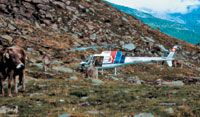Mind Over Miller: Some versatility required
It was easy to write fascinating true stories because I had an unusual practice. It was, I am sure, the most mixed of all mixed-animal practices.
My first book was Most of My Patients Are Animals. Published in 1985, it mostly consisted of stories that had originally appeared in this column. It was easy to write fascinating true stories because I had an unusual practice. It was, I am sure, the most mixed of all mixed-animal practices.
My business card said "Medicine and Surgery of All Animals," and that's what we did. In addition to cattle and sheep ranches, horse-breeding farms, horse-training stables, dog-boarding kennels, and my routine semirural pet practice, the community in which I lived had an enormous exotic-animal population that served the TV and movie industry in neighboring Los Angeles County. There was a private zoo, a circus headquarters adjacent to our animal hospital, an elephant training center, a camel breeding farm, an exotic-bird importer and exporter, and so on.
Many of these facilities still exist half a century later, but they are no longer along our main street. They are now out in the country. For example, farther up the canyon in which I now live are three exotic-animal facilities that serve Hollywood, with an amazing collection of snakes, crocodiles, elephants, lions, tigers, and what have you.
The introduction to Most of My Patients Are Animals was written by James Herriot, the most famous and talented of all veterinary authors. I once told him that I thought he was the best writer of the 20th century. A very modest man, he protested, "Oh, no! I simply tell of my fascinating practice."
"Nonsense," I responded. "You have a boring rural Yorkshire practice. Yet you have become the most successful living author writing about veterinary practice because of your skill. Can you imagine what you could do with my practice?"
Last July, I attended Dr. Ron Fuller's ninth annual animal adventure in Switzerland. It was an indescribable experience in the most beautiful of all foreign countries, featuring an amazing variety of CE experiences for a group of U.S. veterinarians, their spouses, and friends. One of the speakers was a rural Swiss practitioner, Dr. Jürg Eitel of Grono in the Italian district. I called him a Swiss Herriot, but he was also a Swiss Miller because the practice he described is as exotic as mine was, and it included experiences I never had.
For example, how many of us hike mountains with a rucksack full of medication and supplies to treat cattle in areas with no road access? This trekking is common in the Alps, the most beautiful and rugged mountains in Europe. Dr. Eitel sometimes must make calls by helicopter to treat cattle, and he showed us slides of calls he has made to areas in which helicopters could not land. He had to descend on a cable.


Dropping in for a visit. In his rural Swiss practice, Dr. Jürg Eitel sometimes makes calls and transports patients by helicopter.
The Alps are so steep and precipitous that pack mules and horses are still used in some regions, so Dr. Eitel's practice also includes treating them, and his hospital has facilities for both large and small animals.
What a versatile and challenging profession we have.
Robert M. Miller, DVM, is an author and a cartoonist, speaker, and Veterinary Medicine Practitioner Advisory Board member from Thousand Oaks, Calif. His thoughts in "Mind Over Miller" are drawn from 32 years as a mixed-animal practitioner. Visit his Web site at www.robertmmiller.com.